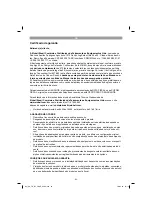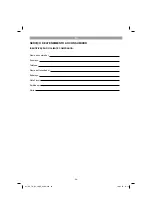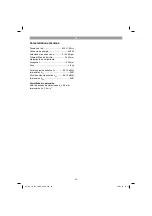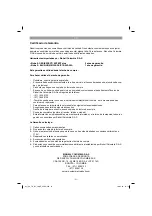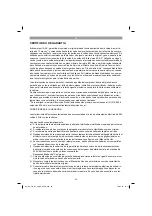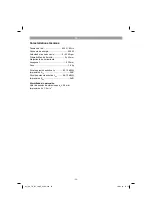
GB
- 20 -
5.1 Setting the screwing depth (Figure 2)
Using the depth setting ring (2) with latching set-
tings you can pre-select the depth to which the
screw is screwed into the workpiece.
PLUS direction:
larger screwing depth
MINUS direction:
smaller screwing depth
The best way to determine the re-quired setting is
with a test screw.
Press the tip of the screw
fi
rmly against the ma-
terial in question until the screwing depth stop (1)
comes up against the workpiece and the coupling
disengages.
The scale (a) can serve as a rough guide if the
depth setting ring (2) should move or if several
screwing depths are needed in alternation.
5.2 Changing the tool insert
To change the tool insert, rotate the screwing
depth stop (1) with the depth setting ring (2) as far
as the maximum screwing depth and pull o
ff
the
tool insert to the front (use pincers if necessary).
5.3 Screwdriving work
It is advisable to use self-centering screws (e.g.
Torx, cross recessed head) as these will enable
you to work safely and reliably. Always make sure
that the tool insert used is of the same size and
shape as the screw.
6. Operation
6.1 ON/OFF switch (4)
To switch on:
Press the switch (4)
Continuous operation:
Secure the switch (4) with the locking button (5)
To switch o
ff
:
Press in the switch (4) brie
fl
y
6.2 Adjusting the speed
You can select the speed by pressing the switch
(4) to a greater or lesser extent.
You can pre-select the speed by turning the
knurled screw in the switch (4).
6.3 Changeover switch (6)
Using the slide switch above the ON/OFF switch
you can select the direction of rotation of the
screwdriver.
7. Replacing the power cable
Danger!
If the power cable for this equipment is damaged,
it must be replaced by the manufacturer or its
authorized after-sales service or similarly trained
personnel to avoid danger.
8. Cleaning, maintenance and
ordering of spare parts
Danger!
Always pull out the mains power plug before star-
ting any cleaning work.
8.1 Cleaning
•
Keep all safety devices, air vents and the
motor housing free of dirt and dust as far as
possible. Wipe the equipment with a clean
cloth or blow it with compressed air at low
pressure.
•
We recommend that you clean the device
immediately each time you have finished
using it.
•
Clean the equipment regularly with a moist
cloth and some soft soap. Do not use
cleaning agents or solvents; these could at-
tack the plastic parts of the equipment. Ensu-
re that no water can seep into the device. The
ingress of water into an electric tool increases
the risk of an electric shock.
8.2 Carbon brushes
In case of excessive sparking, have the carbon
brushes checked only by a quali
fi
ed electrician
and/or an authorized service agent.
Danger!
The carbon brushes should not be rep
laced by anyone but a quali
fi
ed electrician or the
authorized service technician.
8.3 Maintenance
There are no parts inside the equipment which
require additional maintenance.
Anl_SA_TC_DY_500_E_SPK8.indb 20
Anl_SA_TC_DY_500_E_SPK8.indb 20
10.02.16 15:13
10.02.16 15:13


















